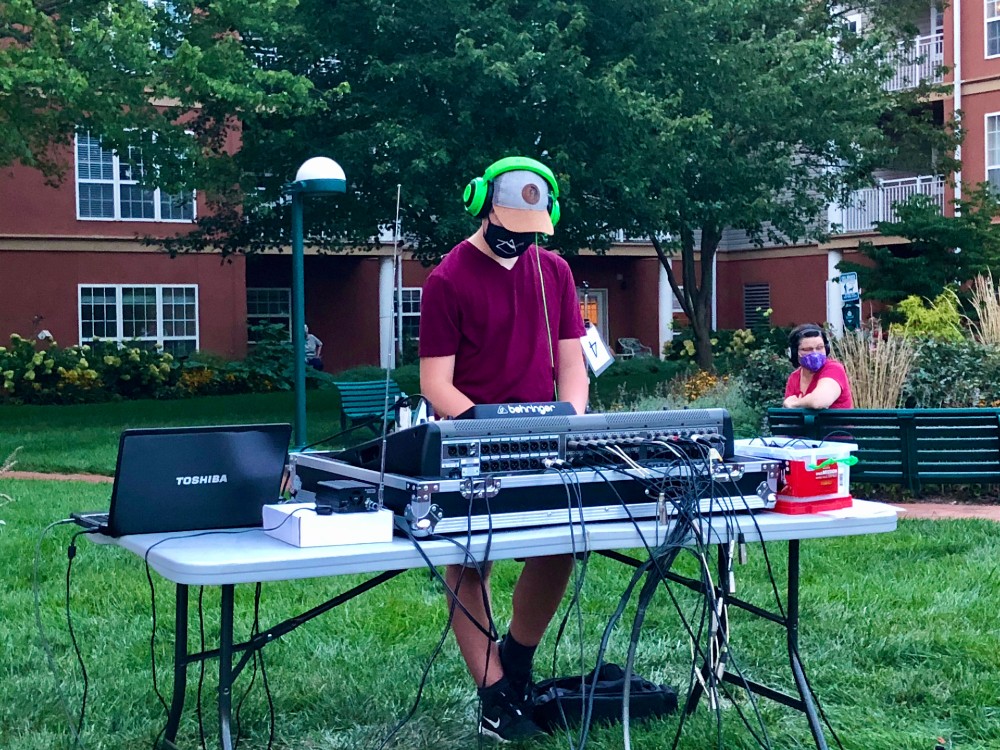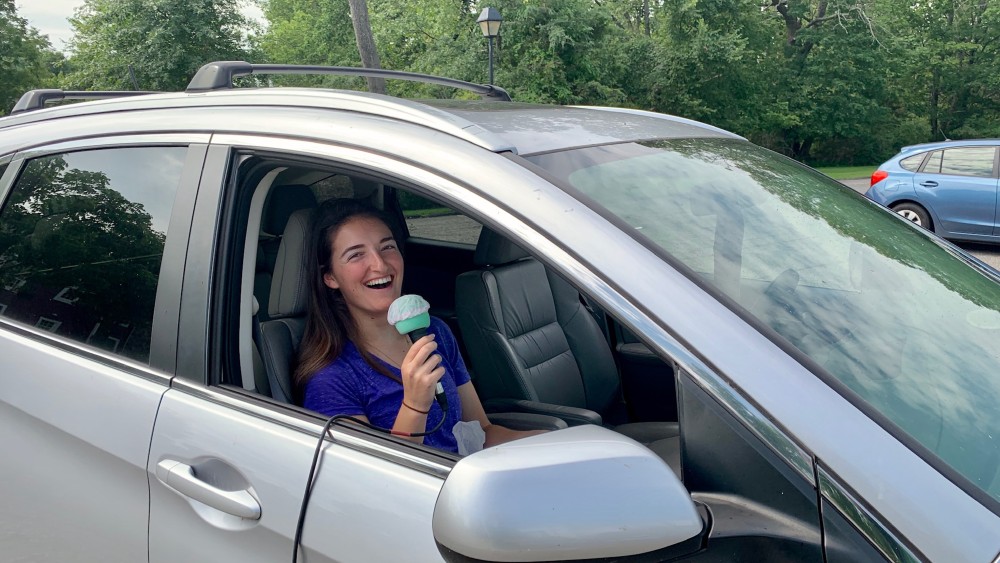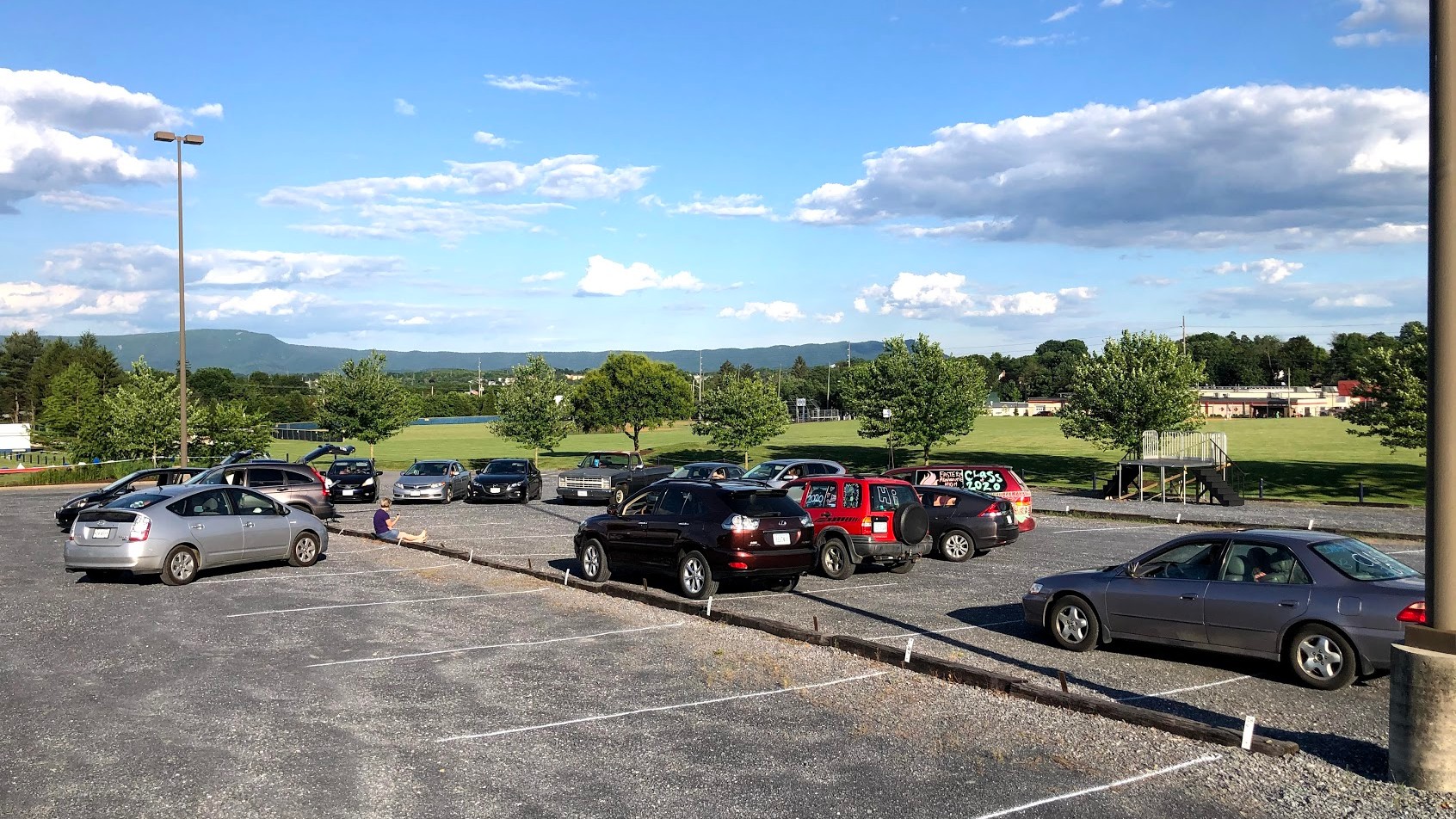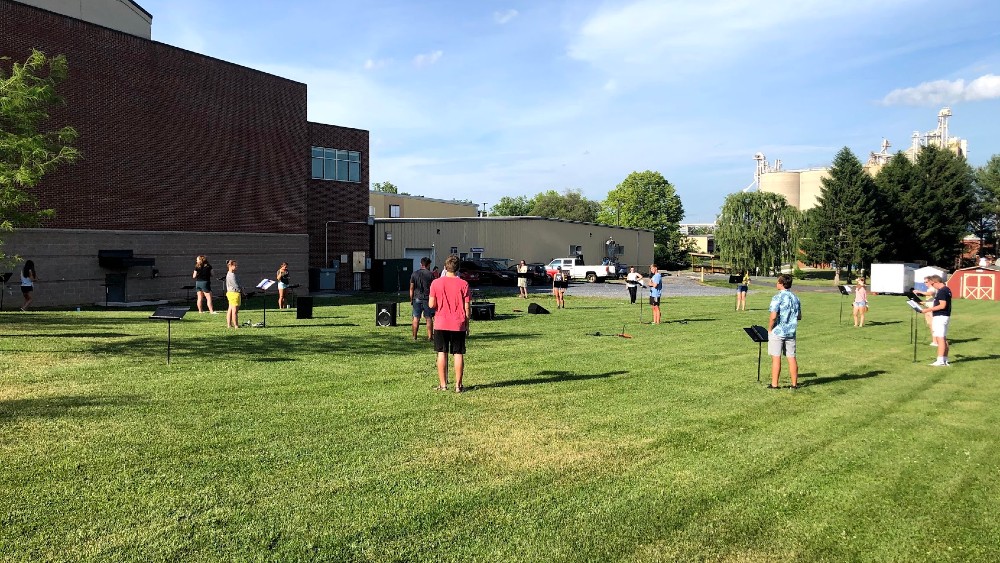
Photo courtesy of Somerset Hills Harmony.
After several long months of not singing together, community choruses are starting to get creative.
The most recent innovation? Drive-in choirs.
I first discovered a drive-in choir when a friend posted about it on Facebook. As I started digging, I was surprised to find that quite a few choruses have already begun experimenting with drive-in choir rehearsals.
Naturally, I had to learn more. So, I reached out to a few movers and shakers in the drive-in choir space to get the scoop.
What is a Drive-In Choir Anyway?

Photo courtesy of David Newman.
The first COVID-19 NATS webinar on the future of singing had the choral world reeling. Would it really be up to two years until choirs could sing together again?
One man had a plan. David Newman, a baritone on the voice faculty of James Madison University, had an idea to put together a socially distanced drive-in rehearsal. Something that could be safe, but effective for singing together.
Newman said he "felt compelled to respond to the webinar, where the message that people heard was that we would not be able to sing together for the foreseeable future." He continued, "I had also just had a conversation with a former student on social media who was understandably frustrated with the limitations of Zoom, but who claimed that physics precluded physically distant music making, which I knew to be untrue."
With a sound system and four wireless microphones, Newman set out to prove that there could be a safe way to sing together again. "I organized a quick gathering and published my first video on May 17," Newman told us.
In the video, singers gathered on the street in their cars and were handed the sanitized microphones. With their windows rolled down, following a conductor, they began to sing together while listening to each other through an amplified speaker.
While it was a successful first attempt, afterwards, Newman came up with even better idea to use FM transmitters in the same way people used them "back in the day" to play sound from a CD player to a car radio. This eliminated the need for an amplifier and potentially was less disrupting for the neighborhood. Newman explained, "I imagined there would be no significant latency in converting analog signals to radio waves, but I wasn’t sure, so I bought a cheap FM transmitter to try it out. The first test using it on May 20, proved that the latency was near zero, which was really exciting!"
After his method was proven effective, Newman wanted to tell the entire choral world that this was a real option for singing together again. So, he set up a list of how-to instructions and started sharing within his network.
Several local groups picked up the idea and ran with it. Newman exclaimed, "I did have trouble, at first, convincing both directors and members to try it. After they had tried it, most couldn’t wait to do it again!"
Running With the Idea
.jpg?width=1000&name=Denneys%20Driveway%20Choir%203%20(1).jpg)
Photo courtesy of Kathryn and Bryce Denney.
Up north, in Massachusetts, Kathryn and Bryce Denney were experimenting with their own version of a "driveway choir."
Kathryn is a professional singer, community theater music director, and former elementary music teacher. Her husband, Bryce, is a pianist and electrical engineer.
Like many musicians, their musical events have been cancelled since March and they were desperately looking for new ways to continue making music together. As they experimented with livestream concerts and virtual concerts, they quickly realized that nothing came close to giving the sense of community and collaboration that a live rehearsal or performance brings.
Thus, the driveway choir was formed.
Bryce Denney said, "We call this the 'driveway choir' because we have literally been using our driveway as the venue. Once we had larger groups, we put the conductor, Kathryn, in the driveway, and had people park nearby in the street where they could see her."
"It's a great way to rehearse as a group and make communal progress on new music," Bryce Denney continued, "In a world in which people have been singing on Zoom with their microphones on mute, driveway choirs allow singers to hear each other, connect with each other, breathe together, blend their voices, sing in tune with true chords and polyphony, and create phrases that are intentional and stylistic."
Of course, having an engineer on hand makes these types of in-performance possibilities more of a reality. Someone who really understands how to make the audio components of outdoor, socially distanced rehearsals and performances, was a vital skill in making this work initially. In fact, Newman's initial research was instrumental in helping the Denneys get their driveway choir up and running.
As the Denneys tell the story, "We already had some experience recording with microphones, mixers, and computers for recording. We decided to try four singers in cars using headsets first. We did this twice, and made videos documenting it. We then met David Newman on Zoom and shared ideas which helped us scale up to events with 20-24 choir members. Now we've booked one per week in different venues for the next month!"
Meanwhile, the instructional materials that the Denneys created inspired another chorus to try a drive-in choir: Somerset Hills Harmony, an a cappella chorus in New Jersey. Starting with just six singers, a director, and two sound technicians, their beta test for a drive-in rehearsal was held in a yard.
Christian Hunter, volunteer for Somerset Hills Harmony, said, "We fed all of the microphones into a mixer and sent the combined sound into an FM transmitter on an unused channel. Everyone had the wireless headset tuned to the same channel and could hear each other as if they were standing side by side! We sang tags. We sang repertoire songs — ballads, up-tempo, homophonic, polyphonic. We followed the director with precise timing and no lag time at all. We tried to break it but couldn’t. We laughed and we cheered!"
After Somerset Hills Harmony's first event, they've been meeting regularly and scaling the event for more singers with the hopes of getting up to 24 singers. They've even already hosted their first drive-in concert!
Hunter said, "One of our members and his wife have been living in a retirement community that has been in lockdown for five months. They were celebrating their 60th anniversary and you better believe that we were going to be there to perform for them." So, they gathered sixteen singers, sixteen cars, set up on the street outside the retirement home, and performed a 30-minute set for the happy couple. And if that doesn't warm your heart, I don't know what will!
So, How Does This All Work?

Photo courtesy of Somerset Hills Harmony.
Well, I'm no audio engineer, but I'll attempt to sum it up for you:
- Every singer has a microphone of sorts, preferably wireless.
- The sound from the microphones is transferred to radio waves and are fed into a mixer.
- The sound then plays through an amplifier system, wireless headphones, or through car radios allowing each singer to hear and sing synchronously.
In terms of equipment needed, the Denneys were able to obtain a 16-channel Behringer mixer, 24 GTD Audio wireless microphones, and an FM transmitter and were able to limit costs to around $2,000. More details can be found in the "Technical Details" section of their website.
Newman worked with 16 G-787 wireless microphones, a mixer, and an FM transmitter. The total cost for his equipment was around $1,400.
And in the case of Somerset Hills Harmony, they already had some equipment on hand. For each singer, all they needed to get was a Shure SM48 handheld microphone and an FM headset purchased from Amazon. The total cost was about $50 per singer.
In terms of space, there are a couple of options available — mainly yards, driveways, and parking lots. It's important to note that cars were utilized because safe social distancing was guaranteed. As Newman put it, it's like having your own "mobile isolation units."
As outdoor singing with masks and wide spaces may become more common, organizations could also switch to powered speakers as monitors instead of the FM transmitter required for cars.
Newman said, "Choruses can probably buy speakers of sufficient quality for about $100 apiece, though quality will improve significantly as they move toward the $200 range or higher. I’d think one would want to have at least one 100-watt RMS speaker per eight participants. It raises the cost per person, but also expands their options moving forward."
What Do Singers Think?

Photo courtesy of Somerset Hills Harmony.
Singer enthusiasm seems to be high with driveway choirs because it's something new and fun to do where they can actually sing together in person.
The Denneys said, "Many singers considered it a breath of fresh air, because they had missed singing with other people for several months. Most people have loved the opportunity to share music with friends... and to make progress as an ensemble. Many participants have driven quite a distance to come back multiple times, because it's so much fun."
Newman said, "Choir directors who have run with this idea seem to have had enthusiastic response from their choirs. Being able to make music together again is a powerful motivator. And most found it to be a more pleasurable experience than they expected. Most participants are unanimous on wanting to do it again."
What's even better is that you can open up these activities outside of your membership.
"It's a different group each week, with a few repeat customers and always a few strangers who hear about it from their friends. We love the way it has taken off! We've had about fifty different people join us during the seven different events we've hosted thus far," said Bryce Denney.
Overcoming Fears

Photo courtesy of David Newman.
If drive-in choirs are so successful, why aren't even more choruses hosting them?
Lack of awareness could be one reason. Insufficient space or funds could be another. Of course, the fear of the health and safety risks is high up there. But the fear of technology is likely what is holding many choirs back from trying this.
Even those with audio engineering experience and those who first embarked on this experiment had some challenges and learning curves.
Bryce Denney said, "We had never done live audio events before March 2020. At first, they required a huge amount of learning and planning, like a field trip or a theatrical production. We found it nerve-wracking to be trying new equipment and techniques while people were waiting around for the event to start. By now, we have learned a lot and solved many problems, so we are confident that it works. We also think that if a steady group wants to use this method, the participants will quickly get used to the technical process, and it will get easier and easier."
Newman said, "We are used to being experts in our field, and unfamiliar stuff can be scary. But you almost certainly have people around you who are comfortable using equipment like this. Be willing to ask questions and challenge assumptions. There are many ways to assemble a workable system. Make the choices that work for you and your group. Just make safe choices."
For those who fear risks, Newman had this advice, "The car sings are as close to risk-free singing as we can get. Certainly safer than most activities we still engage in, because people are completely separated in their own mobile isolation units."
And for those who fear costs, he said, "Your organization and/or people in your choir or community may already own some of this equipment, and may jump at the chance to help bring your choir back together safely. For community or church choirs, also consider that many of your members may gladly donate $100 to be able to sing together again."
Hunter agreed, "The technology is a lot simpler and cheaper than you might think — it just takes effort to source it. If you don’t have resources within the chorus, there are lots of people in the community who would be very excited to team up because this is such a novel approach to music-making amidst the pandemic. The partnerships alone have been fantastic!"
Future Possibilities

Photo courtesy of David Newman.
Newman said, "So far, we've been talking about cars. But you'd need the same sort of technology if you wanted to sing or play instruments from several different rooms in a building, for example. Or if your singers are outdoors, spaced very far apart."
This obviously opens up so many possibilities for consideration!
Newman continued, "I facilitated another outdoor sing, with masks and physical distancing, with some middle school choir directors who wanted to show how this can work to their administrators. The preliminary data from the Colorado University aerosols study suggests that wearing masks and staying outdoors will greatly reduce risk of transmission, so I’m increasingly comfortable with this as an option."
The Denneys advised, "patience, open-mindedness, and to compare this to the bleak world of not singing together at all. It is not the same as being surrounded by the bodies and voices and physical energy of your fellow singers. But it is far more enjoyable than singing into a selfie camera and sending your solo to a video editor for a virtual choir."
Onward
If you had told me a year ago that choruses would be singing together in cars, I would not have believed you. Yet, here we are.
Driveway choirs are the perfect example of the type of innovation needed to move our organizations forward amidst this pandemic. As for me, I'm very much looking forward to participating in a drive-in choir concert in the near future.
Hunter wrapped it up nicely for us, "This was a refreshing return of part of our soul after four months in musical solitude. Things are looking up!"
Resources
- Setting Up a Realtime Physically Distant Rehearsal by David Newman
- The Denney's Website
- The Denney's Driveway Choir #3 Video
- The Denney's Driveway Choir #5 Video
- Making Music Together During COVID Facebook Group
- Hot Rods and Harmony Facebook Group
- "Cars, A Socially Distant Choral Arrangement" by SACRA/PROFANA
- Christian Hunter and the Barbershop Harmony Society are planning to host an upcoming webinar on drive-in choirs. More details on that coming soon. Check back here for the link!

Tori Cook is the former Director of Sales & Marketing at Chorus Connection, an active board member of the Greater Boston Choral Consortium, and a soprano with the Tanglewood Festival Chorus. In a past life, she was the Music Director of the Harborlight Show Chorus and President of Chorus pro-Musica. When not making music, she daydreams about adopting a golden retriever puppy and scuba diving to exotic locations around the world.

